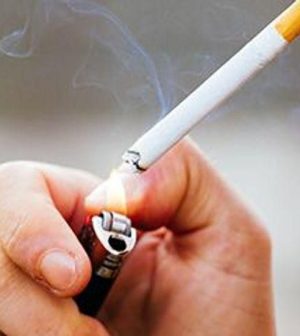- Navigating Your Midlife Crisis: Embracing New Possibilities
- City Raccoons Showing Signs of Domestication
- Mapping the Exposome: Science Broadens Focus to Environmental Disease Triggers
- One Week Less on Social Media Linked to Better Mental Health
- Your Brain Changes in Stages as You Age, Study Finds
- Some Suicide Victims Show No Typical Warning Signs, Study Finds
- ByHeart Formula Faces Lawsuits After Babies Sickened With Botulism
- Switch to Vegan Diet Could Cut Your Greenhouse Gas Emissions in Half
- Regular Bedtime Does Wonders for Blood Pressure
- Dining Alone Could Mean Worse Nutrition for Seniors
U.S. Smoking, Vaping Rates Fell in First Year of Pandemic: CDC

Consider it a silver lining, courtesy of the coronavirus: A new government report reveals that both cigarette smoking and electronic cigarette use dropped slightly among American adults during the first year of the pandemic.
The findings, published March 18 in the Morbidity and Mortality Weekly Report, are based on a survey of more than 31,000 U.S. adults that found 19% of respondents used at least one tobacco product in 2020, down from about 21% in 2019. Broken down, cigarette use fell from 14% to 12.5%, e-cigarette use decreased from 4.5% to 3.7%, while use of cigars, smokeless tobacco and pipes remained stable, according to the researchers from the U.S. Centers for Disease Control and Prevention.
For comparison, 42% of U.S. adults were smokers in 1965.
While CDC officials said public health campaigns and policies prompted the recent decline in smoking, experts point to factors such as tobacco company price hikes and pandemic lifestyle changes.
“People who were mainly social smokers just didn’t have that going on any more,” Megan Roberts, an Ohio State University researcher whose focus is on tobacco use among young adults and teens, told the Associated Press.
Also, parents who had to be at home with their kids full time may have cut back on smoking, and some people may have quit in response to reports that smokers were more likely to develop severe COVID-19, Roberts added.
Ironically, the number of cigarettes sold in the United States actually went up in 2020 — the first such increase in two decades, the Federal Trade Commission reported last year.
It’s possible that while fewer people smoked, those who did were just smoking more.
“That’s a viable hypothesis — that you had people with more smoking opportunities because they weren’t going to work,” David Sweanor, a global tobacco policy expert at the University of Ottawa, told the AP.
In contrast to cigarette and e-cigarette use, the use of alcohol and illicit drugs rose in the United States during the pandemic, the AP reported.
More information
Visit the American Cancer Society for more on the health dangers of smoking.
SOURCE: Associated Press
Source: HealthDay
Copyright © 2025 HealthDay. All rights reserved.










